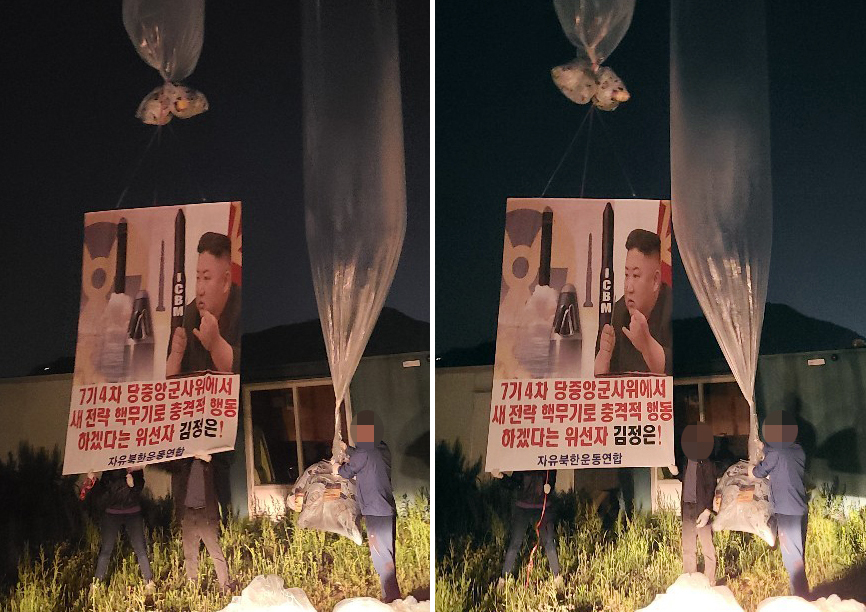It all began in June. North Korea threatened retaliation over the cross-border launch of anti-North propaganda leaflets. Municipal leaders representing residents of border towns demanded a halt to the leafleting. A lawmaker drafted legislation that would ban the practice.
The fate of the law, which was approved in the National Assembly in December and is set to take effect in late March, is hanging in the balance as critics have petitioned the Constitutional Court to review it, saying it infringes on freedom of expression.
But the government contends that the border residents’ right to life is a more pressing priority, and that the ban protects their lives.
Lee Wan-bae, head of the largest border village in Paju, Gyeonggi Province, where activists have often gathered to launch their leaflets, said,
“We’re all adamantly against the leafleting.”
Lee referred to frequent and unwarranted interruptions the leafleting has caused in the villagers’ lives, saying, “For our safety, we’re told to stay in underground shelters by the military every time the balloons float over the border.”
In 2014, North Korea fired machine guns at the balloons. There were no injuries or deaths, but the two neighbors exchanged gunfire at the border.
Dispute over competing rightsThe government says the ban, which makes leafleting a felony punishable by up to three years in jail or a fine of up to 30 million won ($27,000), is necessary to protect border residents. Free speech is important but comes second to the right to life, it maintains.
“There was a real threat. The residents cannot be left exposed to that again,” said Lim Ji-bong, a professor at Sogang Law School in Seoul. When we see competing rights, one has to take precedence and nothing means much without life, Lim noted.
But other legal experts do not see the conflicting rights the same way.
“Leafleting itself threatens no one’s life. Pyongyang says it does,” said Chang Young-soo, a professor of constitutional law at Korea University. “We can’t fold to their unreasonable demands, especially when we draw up our own legislation.”
Cha Jina, a constitutional law professor at Korea University, was more critical, saying, “Why should we protect the border residents’ right to life at the expense of free speech entitled to every Korean?”
The military should protect all South Koreans’ right to life while they also enjoy the right to free expression, Cha added.
“An attack on the border residents is an assault on the entire South Korean population. We can’t just single out the residents and say only their right to life is in danger,” said Kim Sang-kyum, a professor of constitutional law at Dongguk University.
Suzanne Scholte, co-vice chair of the US Committee for Human Rights in North Korea, said, “Of course, no one wants the border residents to feel insecure but there are plenty of other places to launch balloons safely where no residents are around.”
Dispute over precedents for the banThe government maintains that Korea’s Supreme Court has previously ruled in favor of limiting free speech to protect the right to life, and that similar precedents exist in US law. Critics say the Moon Jae-in government is misguided.
“There was a Supreme Court ruling in 2016. But the court was not speaking of an outright ban on leafleting. It discussed adding rules on what the leaflets carry or how they get distributed, which is nothing like the complete ban we see now,” constitutional law professor Chang said.
Joshua Stanton, a Washington-based lawyer who served as a member of the US Army Judge Advocate General’s Corps in Korea between 1998 and 2002, said Seoul’s interpretation of American law is just wrong.
“The Blue House cites Schenck, a century-old decision allowing authoritarian wartime censorship of anti-draft speech. Schenck is one of the most discredited decisions in American legal history. ... The Supreme Court finally overturned it in 1969,” Stanton said, referring to Korea’s presidential office.
A “sweeping censorship law” like Seoul’s ban would never survive a legal challenge in the US, Stanton added.
The Moon government maintains the border leafleting was already banned under joint statements the leaders of the two Koreas exchanged during recent summits, including the inter-Korean meeting in April 2018.
“The joint statements would be binding and carry legal weight had they been ratified at the National Assembly. But that has never taken place,” said Chang, the Korea University law professor.
The constitutional law expert noted he was amazed at the speed the bill was signed into law. It took President Moon’s ruling Democratic Party just six months to push the leafleting ban through the National Assembly and vote on it in December despite mounting opposition from here and overseas.
“When we roll out legislation affecting key civil rights like free speech, there should be either reasonable arguments or solid precedents backing that change,” Chang said, adding, “I see neither.”
By Choi Si-young (
siyoungchoi@heraldcorp.com)




![[Herald Interview] 'Trump will use tariffs as first line of defense for American manufacturing'](http://res.heraldm.com/phpwas/restmb_idxmake.php?idx=644&simg=/content/image/2024/11/26/20241126050017_0.jpg)

![[Health and care] Getting cancer young: Why cancer isn’t just an older person’s battle](http://res.heraldm.com/phpwas/restmb_idxmake.php?idx=644&simg=/content/image/2024/11/26/20241126050043_0.jpg)

